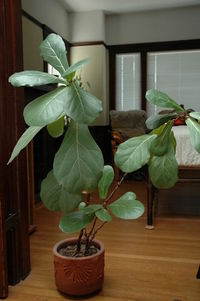Ficus lyrata
| Ficus lyrata subsp. var. | fiddle-leaf fig | |||||||||||||||||||||||||||||||||||||||||||||||||||||||
|---|---|---|---|---|---|---|---|---|---|---|---|---|---|---|---|---|---|---|---|---|---|---|---|---|---|---|---|---|---|---|---|---|---|---|---|---|---|---|---|---|---|---|---|---|---|---|---|---|---|---|---|---|---|---|---|---|

|
|
| ||||||||||||||||||||||||||||||||||||||||||||||||||||||
| ||||||||||||||||||||||||||||||||||||||||||||||||||||||||
Ficus lyrata, commonly known as the fiddle-leaf fig, is a species of fig tree, native to western Africa, from Cameroon west to Sierra Leone. It grows in lowland tropical rainforest.
It is a banyan fig (Ficus subgenus Urostigma) that commonly starts life as an epiphyte high in the crown of another tree; it then sends roots down to the ground which envelop the trunk of the host tree and slowly strangles it. It can also grow as a free-standing tree on its own, growing up to 12-15 m (40-50 ft) tall. The leaves are variable in shape, but often with a broad apex and narrow middle, resembling a fiddle; they are up to 45 cm in 0 long and 30 cm in 0 broad, though usually smaller, with a leathery texture and a wavy margin. The fruit is a green fig 2.5-3 cm (1-¼ in) diameter.
It is a popular ornamental tree in subtropical and tropical gardens, and is also grown as a houseplant, where it usually stays shorter when put into pots than when grown outdoors. Their main horticultural feature are their large leaves. Like other fig species, it can grow to a large tree if planted in the ground. Like all figs, it is frost tender.
Cultivation
Propagation
Pests and diseases
Varieties
Gallery
-
photo 1
-
photo 2
-
photo 3
References
External links
- w:Ficus lyrata. Some of the material on this page may be from Wikipedia, under the Creative Commons license.
- Ficus lyrata QR Code (Size 50, 100, 200, 500)
